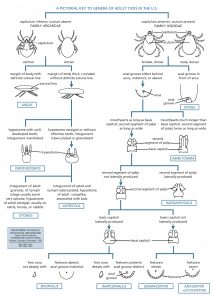Editor’s Note: Information is taken from Truman’s Scientific Guide to Pest Management Operations, available online at the PMP Bookstore.
Chapter 12 of the Truman’s Guide is titled “Fleas, Ticks and Other Ectoparasites.” While its coverage ranges from cat fleas to body lice, dust mites to chiggers, for this article we’re focusing on the information devoted to ticks.
The Guide divides ticks into two categories:
- Hard ticks (Family: Ixodidae) — Species include the brown dog tick (Rhipicephalus sanguineus), American dog tick (Dermacentor variabilis), Rocky Mountain wood tick (D. andersoni), and the groundhog tick (Ixodes cookei).
- Soft ticks (Family: Argasidae) — Species include the common fowl tick (Argas radiatus) and the relapsing fever tick (Ornithodoros turicata).
Tick management
According to the Guide, the brown dog tick is the only species likely to become established in homes, because all of its feeding stages commonly feed on the domestic dog.
In addition to using appropriately labeled chemical options, there are a number of non-chemical strategies to treat ticks, including:
- Remove clutter and debris on the property. This includes any rodent and/or bird nesting materials.
- Pest-proof the structure to guard against such tick hosts as squirrels, raccoons, chipmunks and bats.
- Seal cracks and crevices where ticks can hide, both on the interior and exterior of the structure. Pay close attention to baseboards, doorway and window casings, and carpet edges.
- Recommend to customers to keep grass and weeds cut short in infested areas. This practice increases the chance of tick desiccation in hot weather; discourages rodents, deer and other alternative hosts; and lessens the amount of plant material that may need chemical treatment.
- Recommend to customers to check their pets (especially dogs) on an ongoing basis for ticks. They should also groom their pets frequently and wash bedding regularly to guard against infestation. Infested bedding should be washed carefully — or ideally, disposed of entirely.

Leave A Comment